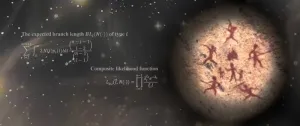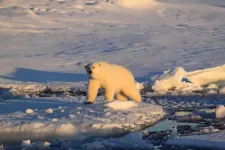(Press-News.org) JooYoung Seo, assistant professor in the School of Information Sciences at the University of Illinois Urbana-Champaign, has been awarded a $649,921 Early Career Development grant from the Institute of Museum and Library Services (IMLS grant RE-254891-OLS-23), under the Laura Bush 21st Century Librarian Program, which supports “developing a diverse workforce of librarians to better meet the changing learning and information needs of the American public by enhancing the training and professional development of librarians, developing faculty and library leaders, and recruiting and educating the next generation of librarians.”
The three-year grant is an extension of Seo’s ongoing project, “MAIDR: Multimodal Access and Interactive Data Representation,” that has received support from the International Society of the Learning Sciences and the Wallace Foundation. Through the initial work, Seo has been developing computer tools that augment visual charts with touchable (braille), readable (text), and audible (sound) representations, to make them more accessible for the visually impaired. In the new project, Seo’s tools will connect the multimodal and accessible data representation with data curators’ day-to-day reproducible workflows, integrating them into reproducible frameworks (e.g., Jupyter Notebook, R Markdown, Quarto) and visualization libraries (e.g., R ggplot2, Python matplotlib).
“Multimodal data representation is not merely an innovation; it is an imperative for inclusivity,” Seo said. “While data visualization is a dominant method in scientific representation, it inherently marginalizes those who are blind and visually impaired, essentially sidelining them from full participation in the scientific discourse. My multimodal data representation challenges this norm by expanding the toolkit beyond the visual. It incorporates auditory, tactile, and verbal methods, thereby democratizing access to knowledge.”
According to Seo, this approach enriches the understanding of data for everyone and offers multiple perspectives that a singular approach could easily miss.
The new project will involve meeting with data curators to assess needs and with blind patrons to shape the tools being created. For that work, Seo will collaborate with his community partners, Data Curation Network (DCN) and the National Federation of the Blind (NFB).
Partners on the project include the National Center for Supercomputing Applications (NCSA), Posit Public Benefit Corporation (FKA, RStudio), and the Chart2Music (C2M) open-source project team.
“By the end of this endeavor, I aspire to deliver a robust, user-friendly, and accessible solution that serves data creators, visually impaired patrons, and people of all abilities who can benefit from multimodal and reproducible data representation. Together, we can democratize data and make it accessible and meaningful for everyone,” said Seo.
Seo is an RStudio double-certified data science instructor, active open-source contributor and accessibility expert who is certified by the International Association of Accessibility Professionals (IAAP). His research focuses on how to make computational literacy more accessible to people with disabilities using multimodal data representation. He earned his PhD from the Learning, Design, and Technology Program at Pennsylvania State University.
END
New project to make data curation accessible
2023-08-31
ELSE PRESS RELEASES FROM THIS DATE:
A step closer to digitizing the sense of smell: Monell Center, Osmo model describes odors better than human panelists
2023-08-31
PHILADELPHIA (August 31, 2023) – A main crux of neuroscience is learning how our senses translate light into sight, sound into hearing, food into taste, and texture into touch. Smell is where these sensory relationships get more complex and perplexing.
To address this question, a research team co-led by the Monell Chemical Senses Center and start-up Osmo, a Cambridge, Mass.-based company spun out of machine learning research done at Google Research, Google DeepMind (formerly known as Google Brain), are investigating how airborne chemicals connect to odor perception in the brain. To this end they discovered that a machine-learning ...
New odor map helps match perceptions of smells with their chemical structure
2023-08-31
Brian K. Lee and colleagues have developed a Principal Odor Map (POM) that models the connections between an odorant’s chemical structure with its perceptual property of smell. The map performed as well as some highly trained human “sniffers” in describing odor quality, and could be used for predicting odor intensity and perceptual similarity between odorants. The map moves researchers closer to being able to match molecular properties of odorants to their perceptual properties, a challenge that has proved difficult for olfactory science. (For other senses, neuroscientists have been able to map light wavelengths ...
Early ancestral bottleneck could’ve spelled the end for modern humans
2023-08-31
How a new method of inferring ancient population size revealed a severe bottleneck in the human population which almost wiped out the chance for humanity as we know it today.
An unexplained gap in the African/Eurasian fossil record may now be explained thanks to a team of researchers from China, Italy and the United States. Using a novel method called FitCoal (fast infinitesimal time coalescent process), the researchers were able to accurately determine demographic inferences by using modern-day human genomic sequences from 3,154 individuals. These findings indicate that early human ancestors went through a prolonged, severe bottleneck in which approximately 1,280 ...
Genomic model suggests population decline in human ancestors
2023-08-31
Between 800,000 and 900,000 years ago, the population of human ancestors crashed, according to a new genomic model by Wangjie Hu and colleagues. They suggest that there were only about 1280 breeding individuals during this transition between the early and middle Pleistocene, and that the population bottleneck lasted for about 117,000 years. The researchers say about 98.7% of the ancestral population was lost at the beginning of the bottleneck. This decline coincided with climate changes that turned glaciations into long-term events, a decrease ...
Student engagement improves calculus class outcomes among undergraduates
2023-08-31
A randomized trial involving 811 undergraduate students at a U.S. Hispanic-Serving Institution (HIS) university found that students assigned to calculus classes focused on collaborative learning and student engagement had a greater understanding of calculus concepts and improved grades compared to those assigned to classes taught in a traditional lecture style. Laird Kramer and colleagues note that the success of the engagement “treatment” occurred across all racial and ethnic groups, academic majors, and genders. Since ...
Pedigree approach estimates surprising genetic mutation rate in baleen whales
2023-08-31
A new estimate of the genetic mutation rate in four wild species of baleen whales suggests that these rates are higher than previous estimates, with some interesting implications for calculations of past whale abundance and low cancer rates. For instance, the new mutation rate determined by Marcos Suárez-Menéndez and colleagues reduces estimates of abundance in pre-exploitation whale populations by 86%, which has implications for population-rebuilding goals of whale conservation programs. The mutation rate—the probability ...
Early ancestral bottleneck could've spelled the end for modern humans
2023-08-31
This release has been removed per the request of the submitting PIO. END ...
Developing silicones that are friendlier toward health and the environment
2023-08-31
Polysiloxanes, the scientific name for silicones, possess exceptional properties, and are used in numerous fields ranging from cosmetics to aerospace. They are absolutely everywhere! However, they have a major flaw, as small, cyclic oligosolixanes—toxic for the environment and identified as an endocrine disruptor—form during their synthesis. To correct this drawback, a team of scientists1 led by a CNRS researcher recently developed a new process for synthesising silicones in a cleaner and more environmentally-friendly ...
Study connects greenhouse gas emissions to polar bear population declines, enabling greater protections under Endangered Species Act
2023-08-31
New research from the University of Washington and Polar Bears International in Bozeman, Montana, quantifies the relationship between greenhouse gas emissions and the survival of polar bear populations. The paper, published online Aug. 31 in Science, combines past research and new analysis to provide a quantitative link between greenhouse gas emissions and polar bear survival rates.
A warming Arctic is limiting polar bears’ access to sea ice, which the bears use as a hunting platform. In ice-free summer months the bears must fast. While in a worst-case scenario ...
Exciting the brain could be key to boosting maths learning, says new study
2023-08-31
Exciting a brain region using electrical noise stimulation can help improve mathematical learning in those who struggle with the subject, according to a new study from the Universities of Surrey and Oxford, Loughborough University, and Radboud University in The Netherlands.
During this unique study, researchers investigated the impact of neurostimulation on learning. Despite the growing interest in this non-invasive technique, little is known about the neurophysiological changes induced and the effect it has on learning.
Researchers found that electrical noise ...


